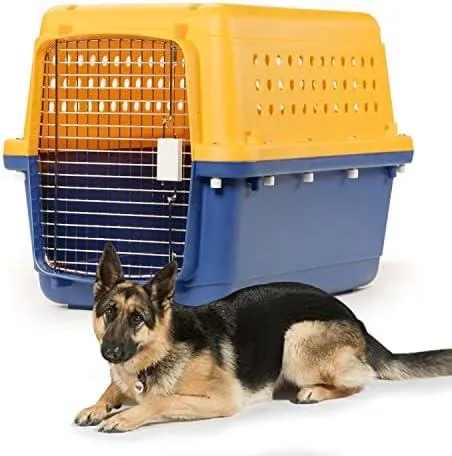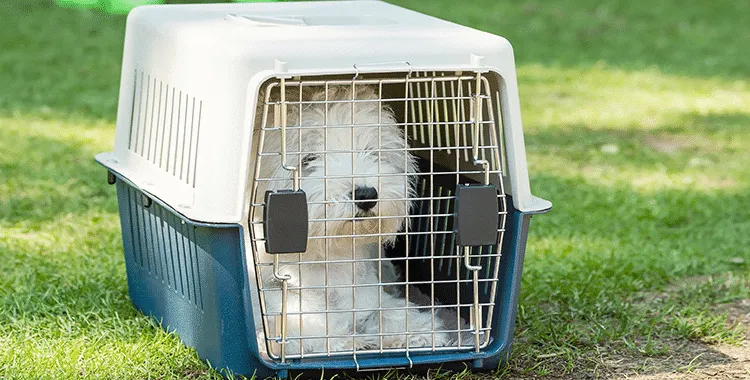Everything You Need to Know About Airline Pet Crate Sizes
Whether you’re planning a vacation with your furry friend or need to transport them somewhere, figuring out the right airline pet crate size can be tricky. As someone who has shipped dogs cross-country a few times, I know firsthand how confusing crate regulations can be. In this article, I’ll break down the different crate size requirements for major carriers and provide tips to make sure your pet travels safely and comfortably.
Carrier Dimensions Vary by Airline
- American Airlines: Your pet’s crate can be no larger than 18 inches long x 13 inches wide x 7.5 inches high.
- Delta: Delta allows slightly larger crates that are a max of 22 inches long x 17 inches wide x 12 inches high.
- United: United’s maximum dimensions are somewhat bigger at 28 inches long x 19 inches wide x 12 inches high.
As you can see, carrier specs differ depending on the carrier. It’s crucial to double check the sizing policies for your specific airline before purchasing a crate. Getting one that’s too big could result in your pet being denied for travel. I’d recommend starting with the smallest size limits to ensure compatibility.
Consider Your Pet’s Comfort
When choosing a carrier, comfort should be a top priority – especially for long flights. While the minimum requirements give you a general size range, it’s a good idea to get a crate that’s not cramped but still cozy. Think about whether your pet likes to stand up or curl up. Also look for well-ventilated models. On one trip, my dog got overheated in a non-breathable plastic crate, so I exclusively use soft-sided carriers now.
You’ll also want to consider your pet’s personality. More anxious dogs may feel safer in a smaller, enclosed space, while bolder pups have room to pace a larger crate. It takes some trial and error to find the ideal fit. When in doubt, it’s better to err on the slightly roomier side for your pet’s peace of mind. Comfort is king when you can’t be there to reassure them.

Invest In ProperID Tags
No matter how carefully you pack, unexpected mix-ups can occur during transport. That’s why it’s critically important to have updated identification on your pet’s crate/carrier and collar. I like to use ProperID tags, which are made of durable aluminum and linked together for tamper-resistance. They have plenty of space to include two phone numbers in case your pet gets lost in transit. Taking extra precautions with ID gives you peace of mind in an emergency.
Provide Essentials and Comfort Items
Most airlines allow you to bring a few necessary things inside the crate to make the journey less stressful. I always pack:
- Fresh water in an airline-approved spill proof bowl
- A few tasty treats to occupy anxious dogs
- Their favorite toy or blanket with a familiar scent
- Ziploc bag of poop bags just in case of an accident
It’s also a good idea to bring a fold-up travel bowl, leash and your vaccination records in your carry-on in case they’re needed at check-in. The more prep work you do, the smoother the process will go when it’s time for departure.
Rehearse Crate Training Early
To avoid issues at the airport, start desensitizing your pup to their carrier well in advance. Make it a positive place by feeding them treats through the door and leaving toys inside. Work up to short practice trips around your home and neighborhood. Look for relaxation signs like tails wagging or lying down calmly before advancing to longer periods. This type of training takes the stress out of vet visits and prevents freak-outs when travel day arrives.

Consider Alternatives For Anxious Pets
If your pet has crate anxiety issues, talk to your veterinarian about anti-anxiety medications that are airline-approved. Some pets may also do better in the cabin with an owner rather than cargo. However, this option often has size/breed/age restrictions and advance booking requirements. It’s cheaper to fly your pet as cargo weight, but you need to seriously consider their stress levels and choose what’s safest. There’s no one-size-fits-all solution.
To summarize, picking an airline pet crate that falls within carrier regulations while prioritizing comfort is key. Proper IDs, supplies and training can reduce travel fears. With preparation, you can give your pet a pleasant flying experience instead of a harrowing ordeal. Safe travels to all four-legged flyers! Let me know if you have any other pet transportation questions.
Airline Pet Crate Size Recommendations
| Pet Type | Weight Range | Recommended Crate Size |
|---|---|---|
| Small Dog | Up to 20 lbs | Soft-sided carrier or hard-sided variety measuring 15″L x 11″W x 11″H |
| Medium Dog | 21-50 lbs | Hard-sided crate measuring 19″L x 13″W x 13″H |
| Large Dog | 51-75 lbs | Hard-sided crate measuring 21″L x 17″W x 15″H |
| Extra Large Dog | Over 75 lbs | Hard-sided crate measuring 24″L x 21″W x 19″H |
| Cat | Any Size | Soft-sided carrier at least 13″L x 10″W x 10″H or larger |
FAQ
-
What sizes are pet airline travel crates?
Most airlines allow crates that are roughly the size of the pet, making them comfortable while preventing too much movement during takeoff and landing. Standard sizes are about 17x12x10 inches for small dogs and cats, and upwards of 24x18x18 inches for larger pets. But it’s best to check each airline’s exact limits.
-
Do all airlines accept pets in crates?
While many airlines permit pets in crates, some only take cats and dogs. However, it’s difficult to hard rules as exceptions are granted. Basically, verify the policies carefully with your selected carrier before showing up to the airport with Fluffy. At the same time, emotional support animals have more flexible rules.

-
What features should a good airline approved pet crate have?
A quality crate for air travel should be sturdy yet lightweight with secure latches and ventilation. Strong plastic or carbon fiber are sort of best to withstand baggage handling. Nevertheless, avoid flimsy wires or fabrics that could harm curious paws. Probably look for International Air Transport Association compliance to satisfy regulators. On the other hand, ask an expert if uncertain about a design.
-
Is my pet too big for the cargo hold?
While most animals can fly in cargo if in an approved crate, very large pets may not fit or be issued an exception. Dogs over 100 pounds for instance rarely get clearance below due to weight limits. But is size alone the only issue? Perhaps call ahead to discuss your pet with an agent. Perhaps options exist beyond an outright ban.
-
What steps can I take to make my pet more comfortable?
In addition to the proper crate, try providing favorite chew toys, perhaps a familiar blanket or shirt with your scent. Some frozen food puzzles can entertain for hours. But is it enough? Consult an expert behaviorist for calming aids if your pet seems anxious. Luckily, ample training and desensitization to travel noises minimizes stress.
-
How can I pick my pet up from the airport?
Once your flight lands, head directly to the cargo facility with ID. Amazingly, animals are often waiting in kennels in cargo for pickup. Airports require patience due to strict timing of unloading planes. However, call ahead if delayed significantly so staff knows to work around schedule changes. On the other hand, try arrive on time to simplify reunions.

-
What happens if my pet gets lost during a connection?
While infrequent, delays do occur in the complex aviation system. If baggage fails to arrive, immediately contact the airline. Yet following paperwork trails and investigating all options takes time. Stunningly, lost reports generally solve within days as most pets have microchips and tracking. But worrying beforehand seems useless – focus positive energy on what you can control instead.
